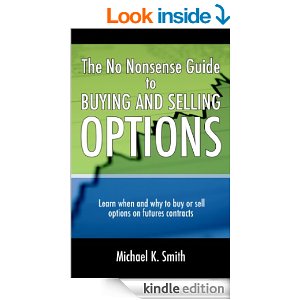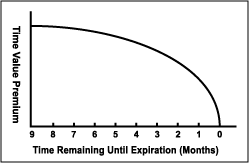Learn How to Sell Options on Futures Contracts

Learn the most effective strategies for buying and selling
options on futures contracts. Also learn producer and consumer
hedging strategies.
*The information contained within this webpage comes from sources
believed to be reliable. No guarantees are being made to the
content's accuracy or completeness.
You have probably heard that approximately 80% of all options
purchased expire worthless when held until expiration. Based on
the research of the Chicago Mercantile Exchange this statistic is
true. This means that the sellers of those options get to keep the
option premiums that were paid to them by the option purchasers. This fact leads to an
inevitable question.
Why would anyone ever purchase an option when the
probabilities are so overwhelmingly in the favor of the option
sellers?
The most enticing aspect of buying options on futures contracts is
the risk to reward profile. The purchaser of an option has limited
risk and theoretically unlimited profit potential. For smaller
investors who do not have enough risk capital or risk tolerance to
withstand a potential margin call, purchasing options may be the
best way to take part in the commodity markets. However, the odds
are certainly in the favor of the option sellers but the risk
potential is unlimited and the profit potential is limited.
If you are one of those investors who has repeatedly lost money
buying options or trading futures, then maybe it is time to add
option selling strategies to your investment portfolio.
Why do the majority of all options purchased expire worthless when
held until expiration?
Consider this example. You just purchased a December $90 crude oil
call option for $700. This includes the option premium plus the commissions and fees. The option
expires in 105 days and the December crude oil futures price is at
$80 per barrel.
Here are 3 potential scenarios that will cause you to lose money:
1) The price of crude oil can trade lower.
2) The price of crude oil can trade sideways.
3) The price of crude oil can trade higher but not by enough to
overcome the transaction costs and time decay of your option by
expiration.
To profit from this option purchase, the crude oil market must move
higher by enough to overcome the commission and fees paid and the time
decay of the option within the 105 day time period. You must not
only choose the direction of the market correctly but also the
approximate distance crude oil prices will move and the correct time
frame the price movement will occur within.
Conversely, the person who sold you the option is not trying to figure out where the
crude oil prices will be by a certain time. They are trying to
figure out where the crude oil prices will not
be by a certain time. This allows the option seller a lot more room
for error.
What is time decay?
Options are by definition a wasting asset because each and every day
the option's premium is being eroded by time. This erosion of
premium accelerates throughout the lifespan of the option. Time
decay is the best friend of option sellers and the worst enemy of option purchasers. The value of out-of-the-money options
is composed almost entirely of time value. The chart below depicts
the acceleration of the time decay of an option with a 9 month
lifespan from its inception to its expiration.

If the probabilities are so disproportionately in favor of
option sellers, then why don't my investment advisors suggest this
strategy to me?
Commodity option selling strategies are not suggested by brokers and
advisors to their clients very often. In my opinion there are two reasons for this:
1) Most financial advisors are not properly licensed to suggest
selling options on commodity futures contracts to their clients.
That requires a Series 3 license. They have no financial incentive
to suggest moving assets out of the portfolios that they manage and
into another account somewhere else. Therefore, the potential merits
of selling options on futures contracts are never mentioned.
2) If they are Series 3 licensed they often find that the generic risk to
reward profile is hard to sell to their clients. The risk is
theoretically unlimited and the profit potential is limited to the
premium you receive from
the sale of the option after commission and fees.
It's much easier for an advisor/broker to sell an idea of a small capital
investment potentially bringing back large quick profits. It's harder
to sell the idea of using a large capital investment to potentially
bring back small
profits over a long period of time.
Option sellers are reminiscent of insurance company owners. Their business
plan is to collect a lot of small premiums year in
and year out knowing that the odds of having to pay out more than
they take in are disproportionately skewed in their favor.
Do you remember Aesop's fable about the tortoise and the hare?
The moral of the story was slow and steady wins the race. There are no
exciting pie in the sky winners or home run trades. If you are seeking huge
profits in a short period of time, then selling commodity options is not for
you.
This information should not be considered a guarantee that option sellers always win. Past
performance is not indicative of future results. There is always
risk of loss. Active risk management is a must
if you intend to sell options on futures contracts.
How do you manage the extra risks involved in selling
options on commodity futures?
1) The first thing an option seller should commit to is not using
more than 50% of the available margin in their account. (ie. If you
have $100,000 in your account you will stop selling options once the
initial margin requirement reaches the $50,000 level.) This money
management technique can help you keep out of margin call trouble.
2) The second way for a call or put option seller to manage their
risk might be to focus on selling deep-out-of-the-money
options. It is this trader's opinion that options should be sold at
least 25% away from the actual futures price of the underlying
commodity to be considered deep-out-of-the-money. (An example would
be selling a November $12.50 soybean call when the underlying
futures contract is at $10.00.)
3)
Another way of managing the risks involved
in selling options is to buy back the options that you sold if they move
against you. As an option seller, you can expect to buy back (cut
losses) on approximately 2 out of every 10 options that you sell.
Many option
sellers buy back options that have doubled in value. (ie. If $700 in
premium was collected by selling the option and now the option is worth $1,400,
the option seller will buy the
option back and take the $700 loss.) Active risk management is the
key to having an effective option selling portfolio.
4)
It also makes sense to diversify your short option strategies
between multiple commodity sectors that have a low correlation to
each other. This can help insulate you from a large premium
expansion caused by a volatility spike within a particular sector of
the commodity markets.
For instance you may want to spread out your commodity option
selling portfolio between grains, meats, metals, energies and
exotics. Your portfolio is not diversified
very well if you sold calls in WTI crude oil, RBOB
unleaded gas and ULSD heating oil because they are very highly
correlated to each other. A volatility spike in crude oil will most
likely affect all three contracts simultaneously.
How does the margin work for selling options on a futures
contract?
The exchanges use SPAN margin software to calculate how much capital will be
necessary for margin on options sold in a portfolio. It uses an
extremely complicated algorithm that is irrelevant to this example.
As a general rule of thumb the margin requirement is approximately
150-200% of the premium collected. (ie. You sold a put and
collected $600 in premium and your margin requirement is $1,400.
Take $1,400 minus $600 and this equals $800. You will need at least
$800 extra cash to be in your account
to meet the initial margin requirements for the put that you sold.) *This depends on the underlying futures market.
How can a portfolio based on selling options on futures
compliment my traditional stock, bond and real estate portfolio?
Alternative investments like options on futures contracts can be
used to diversify and reduce the overall volatility in a traditional
portfolio because they exhibit a low correlation to stocks, bonds
and real estate.
Options on futures investments also have tax advantages. Any gains
from your option selling trades are taxed as 60% long term and 40%
short term regardless of the time frame those investments were held.

Futures and options investing carries significant risk of loss and
is not suitable for some investors. Past performance is not
indicative of future results. Use only risk capital for futures and
options investments.
|
